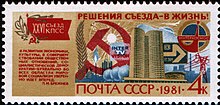Eleventh five-year plan (Soviet Union)
The Eleventh Five-Year Plan, or the 11th Five-Year Plan, of the
The 26th Congress

In his speech to the
Nikolai Tikhonov, the Chairman of the Council of Ministers, told the Congress that industrial output would grow by an estimated 26-28 percent during the five-year plan and capital investment by between 12–15 percent over the
- Growth in the eastern regions to be accelerated.
- Labour reserves of Central Asia to be better utilised, with training of a well-educated workforce improved.
- Modernisation of enterprises in Soviet Europe and existing resources put to better use.
- Territorial production complexes put to better use.
- An increase in the Soviet's role in oversight of the planned economy.
In his presentation to the congress, Tikhonov admitted that
Fulfillment
By the 1980s the
By the 1960s, the goal of increasing the labour surplus had become a major obstacle, caused by factors including the declining birth rate. Labour growth had also stagnated with working population growth remaining at 18 percent between 1971 and 1980. The table below uses the planner's targets as a base for comparison with actual increases in industrial growth due to labour productivity.[16]
| Year | % growth achieved | ||
|---|---|---|---|
| 11th Five-Year Plan | 90 | ||
| 1981 | 62 | ||
| 1982 | 61 | ||
| 1983 | 80 | ||
| 1984 | 93 | ||
According to Nikolai Ryzhkov, the Soviet Premier at the 27th Party Congress, the Eleventh Five-Year Plan had not been able meet the USSR's fuel requirements.[17]
See also
- Five-year plans of the Soviet Union
- First Five-Year Plan (Soviet Union)
- Ninth Five-Year Plan (Soviet Union)
- Tenth Five-Year Plan (Soviet Union)
References
- Notes
- ISBN 978-3-8258-0640-8.
- ^ Dellenbråt 1986, p. 109.
- ^ Dellenbråt 1986, pp. 109–110.
- ^ Dellenbråt 1986, p. 110.
- ^ Dellenbråt 1986, pp. 110–111.
- ^ Dellenbråt 1986, p. 111.
- ^ Dellenbråt 1986, pp. 111–112.
- ^ "Tikhonov Bids for U.S. Trade". Reading Eagle. 27 February 1981.
- ^ "Soviets put squeeze on U.S. for summit". Tri-City Herald. 27 February 1981.
- ISBN 0-8476-7847-4.
- ISBN 978-0-520-39313-4.
- ISBN 0-12-012130-1.
- ISBN 0-12-012130-1.
- ^ Вергасов, Фатех. Организация здорового накала [The Healthy Glow of Organisation] (in Russian). pseudology.org. Retrieved 4 September 2010.
- ISBN 0-415-02406-4.
- ISBN 0-87332-470-6.
- ISBN 0-87332-470-6.
- Bibliography
Dellenbrant, Jan Åke (1986). The Soviet regional dilemma: planning, people, and natural resources.
